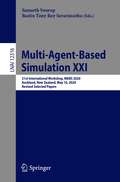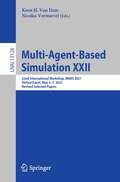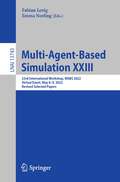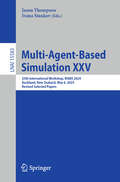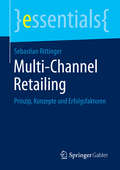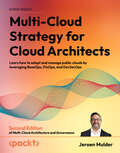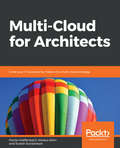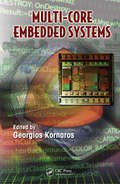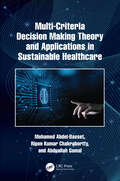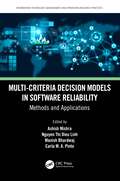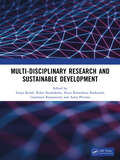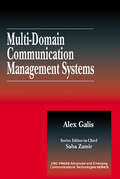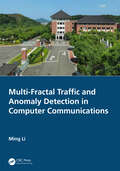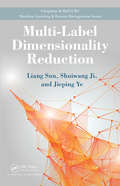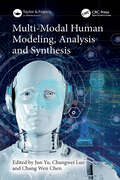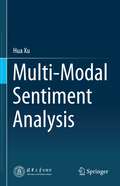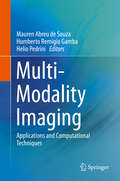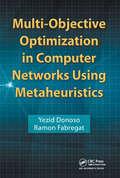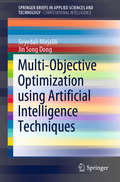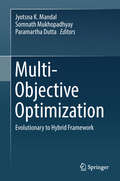- Table View
- List View
Multi-Agent-Based Simulation XXI: 21st International Workshop, MABS 2020, Auckland, New Zealand, May 10, 2020, Revised Selected Papers (Lecture Notes in Computer Science #12316)
by Bastin Tony Roy Savarimuthu Samarth SwarupThis book constitutes the thoroughly refereed post-conference proceedings of the 20th International Workshop on Multi-Agent-Based Simulation, MABS 2020, held in Auckland, New Zealand, in May 2020 collocated with 19th International Conference on Autonomous Agents and Multi-Agent Systems (AAMAS 2020). Due to COVID-19 the workshop has been held online. The 9 revised full papers included in this volume were carefully selected from 11 submissions. The workshop focused on finding efficient solutions to model complex social systems, in such areas as economics, management, organizational and social sciences in general and much more.
Multi-Agent-Based Simulation XXII: 22nd International Workshop, MABS 2021, Virtual Event, May 3-7, 2021, Revised Selected Papers (Lecture Notes in Computer Science #13128)
by Koen H. Van Dam Nicolas VerstaevelThis book constitutes the thoroughly refereed post-conference proceedings of the 21st International Workshop on Multi-Agent-Based Simulation, MABS 2021, held in May 2021 as part of AAMAS 2021. The conference was held virtually due to COVID 19 pandemic. The 14 revised full papers included in this volume were carefully selected from 23 submissions. The workshop focused on finding efficient solutions to model complex social systems, in such areas as economics, management, organizational and social sciences in general. In all these areas, agent theories, metaphors, models, analysis, experimental designs, empirical studies, and methodological principles, all converge into simulation as a way of achieving explanations and predictions, exploration and testing of hypotheses, better designs and systems and providing decision-support in a wide range of applications.
Multi-Agent-Based Simulation XXIII: 23rd International Workshop, MABS 2022, Virtual Event, May 8–9, 2022, Revised Selected Papers (Lecture Notes in Computer Science #13743)
by Emma Norling Fabian LorigThis book constitutes the thoroughly refereed and revised selected papers from the 22nd International Workshop on Multi-Agent-Based Simulation, MABS 2022, which took place virtually during May 8–9, 2022. The conference was originally planned to take place in Auckland, New Zealand, but had to change to an online format due to the COVID-19 pandemic.The 11 papers included in these proceedings were carefully reviewed and selected from 17 submissions. They focus on finding efficient solutions to model complex social systems, in areas such as economics, management, organisational and social sciences in general.
Multi-Agent-Based Simulation XXIV: 24th International Workshop, MABS 2023, London, UK, May 29 – June 2, 2023, Revised Selected Papers (Lecture Notes in Computer Science #14558)
by Luis G. Nardin Sara MehryarThis book constitutes the refereed Proceedings of the 24th International Workshop on Multi-Agent-Based Simulation XXIV, MABS 2023, held in London, UK, during May 29–June 2, 2023. The 11 regular papers presented were carefully reviewed and selected from 27 submissions. The papers are organized in subject areas as follows: MABS methodology and tools; MABS and social behavior; and MABS applications.
Multi-Agent-Based Simulation XXV: 25th International Workshop, MABS 2024, Auckland, New Zealand, May 6, 2024, Revised Selected Papers (Lecture Notes in Computer Science #15583)
by Jason Thompson Ivana StankovThis book constitutes the refereed proceedings of the 25th International Workshop on Multi-Agent-Based Simulation XXV, MABS 2024, held in Auckland, New Zealand, on May 6, 2024. The 7 full papers included in this book were carefully reviewed and selected from 11 submissions. They are organized in topical sections as follows: MABS methodology and tools; MABS education; and MABS applications.
Multi-Carrier Communication Systems with Examples in MATLAB: A New Perspective
by Emad HassanDetailing the advantages and limitations of multi-carrier communication, this book proposes possible solutions for these limitations. Multi-Carrier Communication Systems with Examples in MATLAB: A New Perspective addresses the two primary drawbacks of orthogonal frequency division multiplexing (OFDM) communication systems: the high sensitivity to c
Multi-Channel Retailing: Prinzip, Konzepte und Erfolgsfaktoren (essentials)
by Sebastian RittingerGetrieben durch das rasante Wachstum des Einzelhandels über das Internet (E-Commerce), hat sich das Multi-Channel Retailing fest im Handel etabliert. Unter Multi-Channel Retailing versteht man ein spezifisches Distributionskonzept von Handelsunternehmen, das sich durch den parallelen Einsatz von mehreren Vertriebskanälen auszeichnet. Sebastian Rittinger beschreibt in kompakter Form die zentralen Begriffe und grundlegenden Erscheinungsformen des Multi-Channel Retailing. Aufbauend auf einer Diskussion zentraler Erkenntnisse der Konsumentenverhaltensforschung im Multi-Channel-Kontext werden mit dem Cross-Channel Management sowie dem Retail Branding anschließend die beiden zentralen Erfolgsfaktoren für Multi-Channel Retailer der Zukunft vorgestellt.
Multi-Cloud Architecture and Governance: Leverage Azure, AWS, GCP, and VMware vSphere to build effective multi-cloud solutions
by Jeroen MulderA comprehensive guide to architecting, managing, implementing, and controlling multi-cloud environmentsKey FeaturesDeliver robust multi-cloud environments and improve your business productivityStay in control of the cost, governance, development, security, and continuous improvement of your multi-cloud solutionIntegrate different solutions, principles, and practices into one multi-cloud foundationBook DescriptionMulti-cloud has emerged as one of the top cloud computing trends, with businesses wanting to reduce their reliance on only one vendor. But when organizations shift to multiple cloud services without a clear strategy, they may face certain difficulties, in terms of how to stay in control, how to keep all the different components secure, and how to execute the cross-cloud development of applications. This book combines best practices from different cloud adoption frameworks to help you find solutions to these problems.With step-by-step explanations of essential concepts and practical examples, you'll begin by planning the foundation, creating the architecture, designing the governance model, and implementing tools, processes, and technologies to manage multi-cloud environments. You'll then discover how to design workload environments using different cloud propositions, understand how to optimize the use of these cloud technologies, and automate and monitor the environments. As you advance, you'll delve into multi-cloud governance, defining clear demarcation models and management processes. Finally, you'll learn about managing identities in multi-cloud: who's doing what, why, when, and whereBy the end of this book, you'll be able to create, implement, and manage multi-cloud architectures with confidenceWhat you will learnGet to grips with the core functions of multiple cloud platformsDeploy, automate, and secure different cloud solutionsDesign network strategy and get to grips with identity and access management for multi-cloudDesign a landing zone spanning multiple cloud platformsUse automation, monitoring, and management tools for multi-cloudUnderstand multi-cloud management with the principles of BaseOps, FinOps, SecOps, and DevOpsDefine multi-cloud security policies and use cloud security toolsTest, integrate, deploy, and release using multi-cloud CI/CD pipelinesWho this book is forThis book is for architects and lead engineers involved in architecting multi-cloud environments, with a focus on getting governance right to stay in control of developments in multi-cloud. Basic knowledge of different cloud platforms (Azure, AWS, GCP, VMWare, and OpenStack) and understanding of IT governance is necessary.
Multi-Cloud Strategy for Cloud Architects: Learn how to adopt and manage public clouds by leveraging BaseOps, FinOps, and DevSecOps, 2nd Edition
by Jeroen MulderSolve the complexity of running a business in a multi-cloud environment with practical guidelines backed by industry experience.Purchase of the print or Kindle book includes a free eBook in PDF format.Key FeaturesExplore the benefits of the major cloud providers to make better informed decisionsAccelerate digital transformation with multi-cloud, including the use of PaaS and SaaS conceptsGet the best out of multi-cloud by exploring relevant use cases for data platforms and IoTUnlock insights into top 5 cloud providers in one book - Azure, AWS, GCP, OCI, and Alibaba CloudBook DescriptionAre you ready to unlock the full potential of your enterprise with the transformative power of multi-cloud adoption? As a cloud architect, you understand the challenges of navigating the vast array of cloud services and moving data and applications to public clouds. But with 'Multi-Cloud Strategy for Cloud Architects, Second Edition', you'll gain the confidence to tackle these complexities head-on. This edition delves into the latest concepts of BaseOps, FinOps, and DevSecOps, including the use of the DevSecOps Maturity Model. You'll learn how to optimize costs and maximize security using the major public clouds - Azure, AWS, and Google Cloud. Examples of solutions by the increasingly popular Oracle Cloud Infrastructure (OCI) and Alibaba Cloud have been added in this edition. Plus, you will discover cutting-edge ideas like AIOps and GreenOps. With practical use cases, including IoT, data mining, Web3, and financial management, this book empowers you with the skills needed to develop, release, and manage products and services in a multi-cloud environment. By the end of this book, you'll have mastered the intricacies of multi-cloud operations, financial management, and security. Don't miss your chance to revolutionize your enterprise with multi-cloud adoption.What you will learnChoose the right cloud platform with the help of use casesMaster multi-cloud concepts, including IaC, SaaS, PaaS, and CaCUse the techniques and tools offered by Azure, AWS, and GCP to integrate security Maximize cloud potential with Azure, AWS, and GCP frameworks for enterprise architectureUse FinOps to define cost models and optimize cloud costs with showback and chargebackWho this book is forCloud architects, solutions architects, enterprise architects, and cloud consultants will find this book valuable. Basic knowledge of any one of the major public clouds (Azure, AWS, or GCP) will be helpful.
Multi-Cloud for Architects: Grow your IT business by means of a multi-cloud strategy
by Florian Klaffenbach Markus Klein Suresh SundaresanYour one-stop guide to work with multiple cloud service providers Key Features A practical step-by-step guide that will teach you to architect effective Cloud computing solutions and services efficiently You will learn the key differences in both platforms and how you can interconnect them to each other Eliminate the pain-points of architecting, interconnect and managing multi-cloud services and solutions. Book Description With the passing of time and with technology evolving, organizations all around the globe, from small- to medium-sized enterprises through to companies that are fully equipped, have started migrating or adapting to cloud computing. If you are looking at adapting entirely to any cloud and its services, this book will be your go-to guide to find perfect solutions, irrespective of the size of your infrastructure. This book will teach you effective solutions for overcoming various implementation scenarios. Our book covers two major cloud platforms (AWS and Azure) and provides practical use cases. You will start by designing the building blocks for infrastructure solutions that will involve core cloud platform services, such as compute, networking, storage, and identity, through various cloud providers. You will be able to plan and design solutions across major cloud providers and streamline interconnections and identities. Finally, you will understand the differences between, and the behavior of, both platforms, and you will be able to plan interconnects and identities for single-instance management. By the end of this book, you will know everything you need in order to be able to architect a multi-cloud solution for your organization. What you will learn Get to grips with different cloud offerings according to service and availability model Choose your cloud model, depending on real-world requirements Become familiar with interconnecting and designing multi-cloud solutions according to network, identity, and application Interconnect major cloud providers and frameworks, such as Microsoft Azure/Azure Stack, and AWS, and manage hosting solutions Resolve key show stoppers in a multi-cloud environment Familiarize yourself with example architectures based on real-world projects and solutions Who this book is for If you are a Cloud Architect, Solutions architect, system/network administrator, or a DevOps engineers aware of Cloud solutions and keen to successfully architect them to your organization then, this book is for you.
Multi-Core Embedded Systems (Embedded Multi-Core Systems)
by Georgios KornarosDetails a real-world product that applies a cutting-edge multi-core architectureIncreasingly demanding modern applications—such as those used in telecommunications networking and real-time processing of audio, video, and multimedia streams—require multiple processors to achieve computational performance at the rate of a few giga-operations per second. This necessity for speed and manageable power consumption makes it likely that the next generation of embedded processing systems will include hundreds of cores, while being increasingly programmable, blending processors and configurable hardware in a power-efficient manner.Multi-Core Embedded Systems presents a variety of perspectives that elucidate the technical challenges associated with such increased integration of homogeneous (processors) and heterogeneous multiple cores. It offers an analysis that industry engineers and professionals will need to understand the physical details of both software and hardware in embedded architectures, as well as their limitations and potential for future growth.Discusses the available programming models spread across different abstraction levelsThe book begins with an overview of the evolution of multiprocessor architectures for embedded applications and discusses techniques for autonomous power management of system-level parameters. It addresses the use of existing open-source (and free) tools originating from several application domains—such as traffic modeling, graph theory, parallel computing and network simulation. In addition, the authors cover other important topics associated with multi-core embedded systems, such as:Architectures and interconnectsEmbedded design methodologiesMapping of applications</
Multi-Criteria Decision Making Theory and Applications in Sustainable Healthcare
by Mohamed Abdel-Basset Ripon Kumar Chakrabortty Abduallah GamalMulti-Criteria Decision Making Theory and Applications in Sustainable Healthcare, 1st Edition, is an excellent compilation of current and advanced Multi-Criteria Decision Making (MCDM) techniques and their applications to multiple recent and innovative healthcare analytics problems. The healthcare business has expanded rapidly in recent years, and one of the top priorities in the sector is now the efficacy and efficiency of the various healthcare delivery systems. The entire performance of hospitals must be improved if the healthcare business wants to see an improvement in both the satisfaction and safety of their patients. Finding the best medical facility among many of its competitors may be difficult since there are so many, and they are so highly diverse in terms of features and performance trade-offs. This book has brought together the introductory discussions, fundamental concepts, challenges, and insights of multiple advanced healthcare management problems along with the application of MCDM to obtain the best option among multiple alternatives. A few important takeaways from this book are: Developing an efficient model for supplier performance evaluation and selection in healthcare industries with incomplete information. A computational reliance approach for assessing healthcare service quality aspects and their measurement in an uncertain environment. An efficient and provable approach for recommending suitable mobile healthcare products under uncertain environments. Establishing a decision-making strategy to select healthcare waste treatment methods. Assessing the usability of mHealth applications in practice related to type 2 diabetes. The successful outcome of this book will enable a decision-maker or practitioner to pick a suitable MCDM technique when making decisions to prioritize the selection criteria of any healthcare-related problems to ensure a sustainable practice. .
Multi-Criteria Decision Models in Software Reliability: Methods and Applications (Information Technology, Management and Operations Research Practices)
by Nguyen Thi Dieu Linh Ashish Mishra Carla M. A. Pinto Manish BhardwajThis book provides insights into contemporary issues and challenges in multi-criteria decision models. It is a useful guide for identifying, understanding and categorising multi-criteria decision models, and ultimately implementing the analysis for effective decision-making. The use of multi-criteria decision models in software reliability engineering is a relatively new field of study, and this book collects all the latest methodologies, tools and techniques in one single volume. It covers model selection, assessment, resource allocation, release management, up-grade planning, open-source systems, bug tracking system management and defect prediction. Multi-Criteria Decision Models in Software Reliability: Methods and Applications will cater to researchers, academicians, post-graduate students, software developers, software reliability engineers and IT managers.
Multi-Disciplinary Research and Sustainable Development
by Asma Perveen Rohit Kandakatla Tanya Buddi Rameshrao Nitin Kotkunde Upadrasta RamamurtyThe Proceedings of the 2nd International Conference on Multi-Disciplinary Research and Sustainable Devel□opment – 2025 encapsulate the collective efforts of researchers, academicians, industry professionals, and policymakers in addressing the critical challenges of sustainability through a multi-disciplinary approach. In a world where rapid industrialization, urban expansion, and technological advancements continuously reshape our environment, the need for innovative, scalable, and sustainable solutions has never been greater.
Multi-Domain Communication Management Systems (Advanced & Emerging Communications Technologies)
by Alex GalisAmong the leading challenges faced by systems managers today is the coherent management of network resources in a multi-domain, multi-environment. The MISA Project - Management of Integrated SDH and ATM Networks - brought together researchers from 17 organizations to explore and advance the state of the art in developing enabling mechanisms for end
Multi-Fractal Traffic and Anomaly Detection in Computer Communications
by Ming LiThis book provides a comprehensive theory of mono- and multi-fractal traffic, including the basics of long-range dependent time series and 1/f noise, ergodicity and predictability of traffic, traffic modeling and simulation, stationarity tests of traffic, traffic measurement and the anomaly detection of traffic in communications networks. Proving that mono-fractal LRD time series is ergodic, the book exhibits that LRD traffic is stationary. The author shows that the stationarity of multi-fractal traffic relies on observation time scales, and proposes multi-fractional generalized Cauchy processes and modified multi-fractional Gaussian noise. The book also establishes a set of guidelines for determining the record length of traffic in measurement. Moreover, it presents an approach of traffic simulation, as well as the anomaly detection of traffic under distributed-denial-of service attacks. Scholars and graduates studying network traffic in computer science will find the book beneficial.
Multi-Label Dimensionality Reduction (Chapman & Hall/CRC Machine Learning & Pattern Recognition)
by Liang Sun Shuiwang Ji Jieping YeSimilar to other data mining and machine learning tasks, multi-label learning suffers from dimensionality. An effective way to mitigate this problem is through dimensionality reduction, which extracts a small number of features by removing irrelevant, redundant, and noisy information. The data mining and machine learning literature currently lacks
Multi-Level Bayesian Models for Environment Perception
by Csaba BenedekThis book deals with selected problems of machine perception, using various 2D and 3D imaging sensors. It proposes several new original methods, and also provides a detailed state-of-the-art overview of existing techniques for automated, multi-level interpretation of the observed static or dynamic environment. To ensure a sound theoretical basis of the new models, the surveys and algorithmic developments are performed in well-established Bayesian frameworks. Low level scene understanding functions are formulated as various image segmentation problems, where the advantages of probabilistic inference techniques such as Markov Random Fields (MRF) or Mixed Markov Models are considered. For the object level scene analysis, the book mainly relies on the literature of Marked Point Process (MPP) approaches, which consider strong geometric and prior interaction constraints in object population modeling. In particular, key developments are introduced in the spatial hierarchical decomposition of the observed scenarios, and in the temporal extension of complex MRF and MPP models. Apart from utilizing conventional optical sensors, case studies are provided on passive radar (ISAR) and Lidar-based Bayesian environment perception tasks. It is shown, via several experiments, that the proposed contributions embedded into a strict mathematical toolkit can significantly improve the results in real world 2D/3D test images and videos, for applications in video surveillance, smart city monitoring, autonomous driving, remote sensing, and optical industrial inspection.
Multi-Modal Human Modeling, Analysis and Synthesis
by Jun Yu Chang Wen Chen Changwei LuoIn today’s world, where intelligent technologies are deeply transforming human-computer interaction and virtual reality, multi-modal human modeling, analysis and synthesis have become central topics in computer vision. As application scenarios grow increasingly complex, new technologies continue to emerge to address these challenges. These techniques demand systematic summarization and practical guidance.To meet this need, Multi-Modal Human Modeling, Analysis and Synthesis aims to adopt a structured perspective, building a comprehensive technical framework for multi-modal human modeling, analysis and synthesis—progressing from local details to holistic perspectives, and from face features to body dynamics.This book begins by examining the anatomy structures and characteristics of human faces and bodies, then analyzes how traditional methods and deep learning approaches provide robust optimization solutions for modeling. For example, it explores how to address challenges in face recognition caused by lighting changes, occlusions, face expressions and aging, as well as methods for body localization, reconstruction, recognition and anomaly detection in multi-modal scenarios. It also explains how multi-modal data can drive realistic face and body synthesis. A standout feature is its focus on Huawei’s MindSpore framework, bridging the gap between algorithms and engineering through practical case studies. From building face detection and recognition pipelines with the MindSpore toolkit to accelerating model training via automatic parallel computing, and solving large language model (LLM) training challenges, each step is supported by reproducible code and design logic.Designed for researchers and engineers in computer vision and AI, this book balances theoretical foundations with industry-ready technical details. Whether you aim to enhance the reliability of biometric recognition, explore creative possibilities in virtual-real interactions or optimize the deployment of deep learning frameworks, this guide serves as an essential link between academic advancements and real-world applications.
Multi-Modal Sentiment Analysis
by Hua XuThe natural interaction ability between human and machine mainly involves human-machine dialogue ability, multi-modal sentiment analysis ability, human-machine cooperation ability, and so on. To enable intelligent computers to have multi-modal sentiment analysis ability, it is necessary to equip them with a strong multi-modal sentiment analysis ability during the process of human-computer interaction. This is one of the key technologies for efficient and intelligent human-computer interaction. This book focuses on the research and practical applications of multi-modal sentiment analysis for human-computer natural interaction, particularly in the areas of multi-modal information feature representation, feature fusion, and sentiment classification. Multi-modal sentiment analysis for natural interaction is a comprehensive research field that involves the integration of natural language processing, computer vision, machine learning, pattern recognition, algorithm, robot intelligent system, human-computer interaction, etc. Currently, research on multi-modal sentiment analysis in natural interaction is developing rapidly. This book can be used as a professional textbook in the fields of natural interaction, intelligent question answering (customer service), natural language processing, human-computer interaction, etc. It can also serve as an important reference book for the development of systems and products in intelligent robots, natural language processing, human-computer interaction, and related fields.
Multi-Modality Imaging: Applications and Computational Techniques
by Mauren Abreu de Souza Humberto Remigio Gamba Helio PedriniThis book presents different approaches on multi-modality imaging with a focus on biomedical applications. Medical imaging can be divided into two categories: functional (related to physiological body measurements) and anatomical (structural) imaging modalities.In particular, this book covers imaging combinations coming from the usual popular modalities (such as the anatomical modalities, e.g. X-ray, CT and MRI), and it also includes some promising and new imaging modalities that are still being developed and improved (such as infrared thermography (IRT) and photoplethysmography imaging (PPGI)), implying potential approaches for innovative biomedical applications.Moreover, this book includes a variety of tools on computer vision, imaging processing, and computer graphics, which led to the generation and visualization of 3D models, making the most recent advances in this area possible. This is an ideal book for students and biomedical engineering researchers covering the biomedical imaging field.
Multi-Net Optimization of VLSI Interconnect
by Konstantin Moiseev Avinoam Kolodny Shmuel WimerThis book covers layout design and layout migration methodologies for optimizing multi-net wire structures in advanced VLSI interconnects. Scaling-dependent models for interconnect power, interconnect delay and crosstalk noise are covered in depth, and several design optimization problems are addressed, such as minimization of interconnect power under delay constraints, or design for minimal delay in wire bundles within a given routing area. A handy reference or a guide for design methodologies and layout automation techniques, this book provides a foundation for physical design challenges of interconnect in advanced integrated circuits.
Multi-Objective Optimization in Computer Networks Using Metaheuristics
by Yezid Donoso Ramon FabregatMetaheuristics are widely used to solve important practical combinatorial optimization problems. Many new multicast applications emerging from the Internet-such as TV over the Internet, radio over the Internet, and multipoint video streaming-require reduced bandwidth consumption, end-to-end delay, and packet loss ratio. It is necessary to design an
Multi-Objective Optimization using Artificial Intelligence Techniques (SpringerBriefs in Applied Sciences and Technology)
by Jin Song Dong Seyedali MirjaliliThis book focuses on the most well-regarded and recent nature-inspired algorithms capable of solving optimization problems with multiple objectives. Firstly, it provides preliminaries and essential definitions in multi-objective problems and different paradigms to solve them. It then presents an in-depth explanations of the theory, literature review, and applications of several widely-used algorithms, such as Multi-objective Particle Swarm Optimizer, Multi-Objective Genetic Algorithm and Multi-objective GreyWolf Optimizer Due to the simplicity of the techniques and flexibility, readers from any field of study can employ them for solving multi-objective optimization problem. The book provides the source codes for all the proposed algorithms on a dedicated webpage.
Multi-Objective Optimization: Evolutionary to Hybrid Framework
by Paramartha Dutta Somnath Mukhopadhyay Jyotsna K. MandalThis book brings together the latest findings on efficient solutions of multi/many-objective optimization problems from the leading researchers in the field. The focus is on solving real-world optimization problems using strategies ranging from evolutionary to hybrid frameworks, and involving various computation platforms. The topics covered include solution frameworks using evolutionary to hybrid models in application areas like Analytics, Cancer Research, Traffic Management, Networks and Communications, E-Governance, Quantum Technology, Image Processing, etc. As such, the book offers a valuable resource for all postgraduate students and researchers interested in exploring solution frameworks for multi/many-objective optimization problems.
